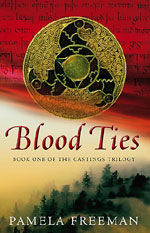Why Pamela Freeman hates the olden times…
 When Pamela Freeman was in the UK recently, we had a fascinating conversation about technology in fantasy (I felt quite awed at her knowledge!). And Pamela promised to write down some of her thoughts on the subject for our blog. So, in honour of Blood Ties (UK/US), her debut fantasy out this month, here it is:
When Pamela Freeman was in the UK recently, we had a fascinating conversation about technology in fantasy (I felt quite awed at her knowledge!). And Pamela promised to write down some of her thoughts on the subject for our blog. So, in honour of Blood Ties (UK/US), her debut fantasy out this month, here it is:
Do you ever get the feeling that most epic fantasy is set in the same time? Olden times – vaguely pre-industrial, vaguely medieval, vaguely Dark Ages … often a bit of each. One example I read recently – a society which had tailored jackets but no socks!
So often, fantasy authors stick technologies from widely different times together as though every culture prior to the invention of the steam engine was the same. The point of history is that things change – and this includes technology.
Technology! I hear you exclaim. They didn’t have technology then!
But they did. It didn’t use electricity, but it was technology nonetheless.
Just look at boats. It was the development of the Viking long-boat in the 700s that allowed the Norse invasion of Europe. The Vikings, over a couple of hundred years, developed a shallow-draught vessel which was seaworthy and which could carry a reasonably sized raiding party up any navigable river (the Seine, the Thames…). It differed from the Roman galley (which was larger and with a deeper draught) in its ability to go far inland, in its manoeuvrability and in the ease with which it could be beached or launched on any shelving shore.You can see the development of this technology quite clearly in the remnant vessels we have. Once the boat was big enough and strong enough, Viking trade blossomed – and so did Viking raids. Europe shifted radically as a consequence. The Normans were originally ‘Norsemen’; they invaded mainland Europe well before they invaded England.
Boat-building technology was the basis for a civilization – and for the destruction of others. But it didn’t freeze in place – the longboat gave way to the cog, the barque, the galleon … and the clipper, the paddle steamer, the steamboat, the ocean liner, the aircraft carrier, the submarine …
Boat-building is just one example; every trade could be discussed in the same way. Boats are in my mind because I’ve just finished the second book in the Castings Trilogy, Deep Water, and in that book we go back a thousand years in ‘story time’ and we see boats like these being built. In the third book, a thousand years later, other characters will be on a trading ship, and I am being very careful to show that boat-building technology has changed.
And also clothes, saddles, horse-breeding, hearths and chimneys, weapons, living quarters, hairstyles, boots, drinking-cups, glassmaking …
This has two purposes: first, it helps with world-building. I want my readers to feel that a thousand years has indeed passed. That this place, this particular culture, has shifted over time in a believable way. Secondly, I want to do it because I get very annoyed by stories where the passage of time somehow has no effect on ordinary life – as though the fabulous ability of human beings to invent new stuff just doesn’t operate in fantasy worlds.
That’s why I hate the ‘olden time’ where so much fantasy takes place. It spits in the face of every craftsperson who worked hard to improve their techniques. It ignores the sweat and toil of thousands of unnamed people, men and women, who improved everyday life incrementally over our history. Each one of them was a person of their time – starting with the technology of their day, and adding to it.
I’m not saying that technology in fantasy worlds should slavishly ape our own – those worlds have different histories, and their technologies will be different as a result. But there are some things which shouldn’t – wouldn’t – exist in the same culture at the same time, and to stick everything pre-industrial in together, willy-nilly, is bad world-building. A culture with tailored jackets would have found something better to protect the feet than strips of rag. Maybe not knitting, as our culture did. Maybe something else, like fur or sewn tubes of cloth – or the elastic skin of a fabulous animal, now bred for just this purpose, its wonderful magic debased into keeping humans blister-free.
I know I haven’t got all the technology in the Castings Trilogy right. I’m not sure anyone could get everything right and actually finish a book by the time they died! But we could do it better, I think.
